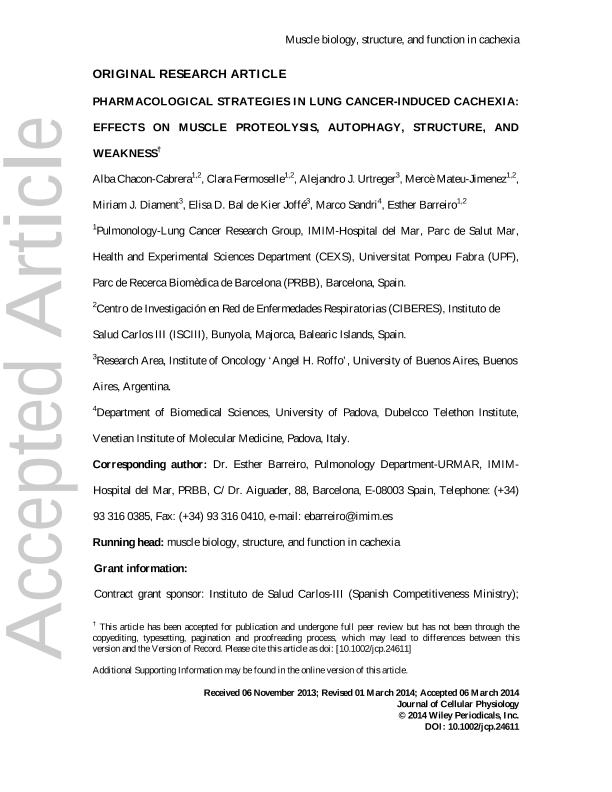Artículo
Pharmacological strategies in lung cancer-induced cachexia: effects on muscle proteolysis, autophagy, structure, and weakness
Chacon Cabrera, Alba; Fermoselle, Clara; Urtreger, Alejandro Jorge ; Mateu Jimenez, Mercè; Diament, Miriam; Bal, Elisa Dora
; Mateu Jimenez, Mercè; Diament, Miriam; Bal, Elisa Dora ; Sandri, Marco; Barreiro, Eshter
; Sandri, Marco; Barreiro, Eshter
 ; Mateu Jimenez, Mercè; Diament, Miriam; Bal, Elisa Dora
; Mateu Jimenez, Mercè; Diament, Miriam; Bal, Elisa Dora ; Sandri, Marco; Barreiro, Eshter
; Sandri, Marco; Barreiro, Eshter
Fecha de publicación:
07/2014
Editorial:
Wiley
Revista:
Journal of Cellular Physiology
ISSN:
0021-9541
e-ISSN:
1097-4652
Idioma:
Inglés
Tipo de recurso:
Artículo publicado
Clasificación temática:
Resumen
Muscle wasting and cachexia are important systemic manifestations of highly prevalent conditions including cancer. Inflammation, oxidative stress, autophagy, ubiquitin-proteasome system, nuclear factor (NF)-kB, and mitogen activated protein kinases (MAPK) are involved in the pathophysiology of cancer cachexia. Currently available treatment is limited and data demonstrating effectiveness in in vivo models are lacking. Our objectives were to explore in respiratory and limb muscles of lung cancer (LC) cachectic mice whether proteasome, NF-kB, and MAPK inhibitors improve muscle mass and function loss through several molecular mechanisms. Body and muscle weights, limb muscle force, protein degradation and the ubiquitin-proteasome system, signaling pathways, oxidative stress and inflammation, autophagy, contractile and functional proteins, myostatin and myogenin, and muscle structure were evaluated in the diaphragm and gastrocnemius of LC (LP07 adenocarcinoma) bearing cachectic mice (BALB/c), with and without concomitant treatment with NF-kB (sulfasalazine), MAPK (U0126), and proteasome (bortezomib) inhibitors. Compared to control animals, in both respiratory and limb muscles of LC cachectic mice: muscle proteolysis, ubiquitinated proteins, autophagy, myostatin, protein oxidation, FoxO-1, NF-kB and MAPK signaling pathways, and muscle abnormalities were increased, while myosin, creatine kinase, myogenin, and slow- and fast-twitch muscle fiber size were decreased. Pharmacological inhibition of NF-kB and MAPK, but not the proteasome system, induced in cancer-induced cachectic animals, a substantial restoration of muscle mass and force through a decrease in muscle protein oxidation and catabolism, myostatin, and autophagy, together with a greater content of myogenin, and contractile and functional proteins. These findings may offer new therapeutic strategies in cancer-induced cachexia.
Palabras clave:
Lung Cancer
,
Cachexia
,
Pharmacology
,
Autophagy
Archivos asociados
Licencia
Identificadores
Colecciones
Articulos(OCA HOUSSAY)
Articulos de OFICINA DE COORDINACION ADMINISTRATIVA HOUSSAY
Articulos de OFICINA DE COORDINACION ADMINISTRATIVA HOUSSAY
Citación
Chacon Cabrera, Alba; Fermoselle, Clara; Urtreger, Alejandro Jorge; Mateu Jimenez, Mercè; Diament, Miriam; et al.; Pharmacological strategies in lung cancer-induced cachexia: effects on muscle proteolysis, autophagy, structure, and weakness; Wiley; Journal of Cellular Physiology; 229; 11; 7-2014; 1660-1672
Compartir
Altmétricas



